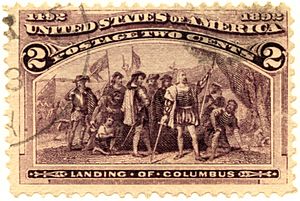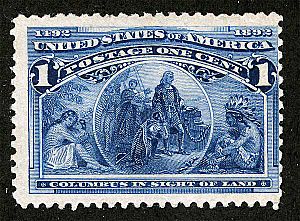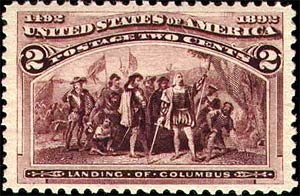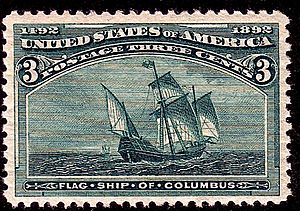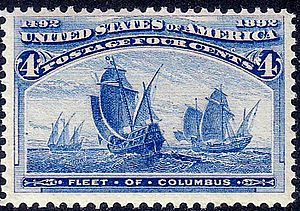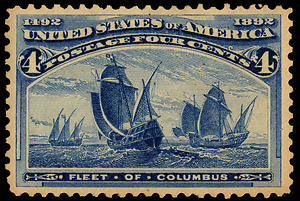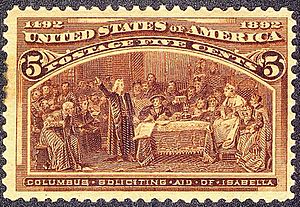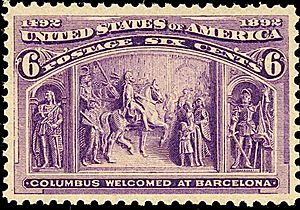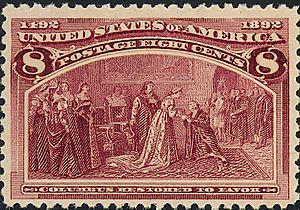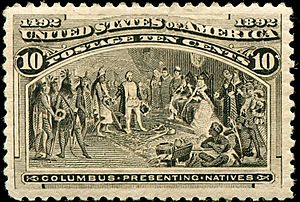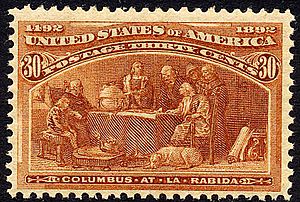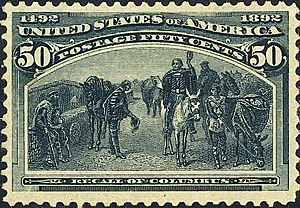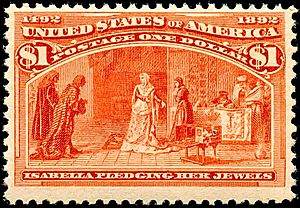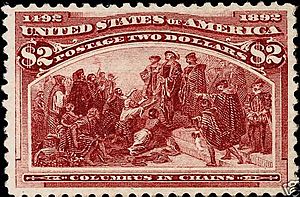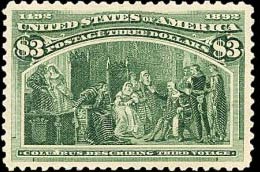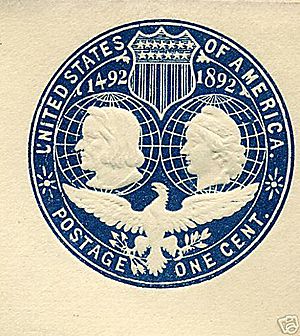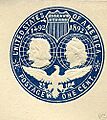Columbian Issue facts for kids
The Columbian Issue, also known as the Columbians, is a special set of 16 postage stamps. The United States released them in 1893. They were made to celebrate the World's Columbian Exposition. This big fair happened in Chicago that year.
These stamps were the very first commemorative stamps ever issued by the United States. They show different important moments in the life of Christopher Columbus. Today, stamp collectors really value these beautiful, detailed stamps.
Contents
- History of the Columbian Stamps
- 1¢ Stamp: Columbus Sees Land
- 2¢ Stamp: Landing of Columbus
- 3¢ Stamp: Columbus's Flagship
- 4¢ Stamp: Fleet of Columbus
- 5¢ Stamp: Columbus Asks for Help
- 6¢ Stamp: Columbus Welcomed
- 8¢ Stamp: Columbus Back in Favor
- 10¢ Stamp: Columbus Presents Natives
- 15¢ Stamp: Columbus Announces Discovery
- 30¢ Stamp: Columbus at La Rabida
- 50¢ Stamp: Recall of Columbus
- $1 Stamp: Isabella Pledges Jewels
- $2 Stamp: Columbus in Chains
- $3 Stamp: Columbus Describes Third Voyage
- $4 Stamp: Isabella and Columbus
- $5 Stamp: Columbus Portrait
- Related Releases
- Commemoratives Commemorated
- Images for kids
- See also
History of the Columbian Stamps
The Columbian stamps were made by a company called the American Banknote Company. This company had a contract to print U.S. postage stamps. Usually, the company paid for new stamp designs. But for the Columbian stamps, the Post Office decided to pay for the designs and plates.
This new deal made the stamps much more expensive to produce. People criticized this decision. The stamps were also twice the size of normal stamps, which the company said was why they cost more.
The first 15 stamps in the set went on sale on January 2, 1893. They were available all over the country, not just at the Exposition. This set had more different stamp values than ever before. It included stamps worth $1, $2, $3, $4, and $5. Before this, no U.S. stamp had cost more than 90 cents!
A 16th stamp, an 8-cent one, was added in March. This was because the fee for sending a registered letter had just been lowered. The total value of all 16 stamps was $16.34. This was a lot of money back in 1893! Because they were so expensive, only a few of the high-value stamps were sold. Any stamps that didn't sell were destroyed after April 12, 1894. In total, over 2 billion Columbian stamps were printed.
People had mixed feelings about the Columbian Issue at the time. Many liked them, and they sold well. However, some people didn't approve. A group called the Society for the Suppression of Speculative Stamps was formed. They thought the Chicago Exposition wasn't important enough for special stamps. Some collectors also felt the Post Office was just trying to make money from the growing hobby of philately (stamp collecting).
The $5 stamp was even made fun of by the Chicago Tribune newspaper. They said it could only be used for mailing a very heavy package of books. The value of these stamps didn't go up right away after they were taken off sale. This was because many people bought them to resell, creating too many stamps on the market. However, today, a full set of Columbian stamps in good condition can be worth $100,000 or more!
The Columbian stamps were also important because they were the last U.S. stamps printed by a private company for many years. In 1894, the U.S. Bureau of Engraving and Printing took over. They offered a lower price to print stamps. The Bureau then printed almost all U.S. stamps for decades. Private companies didn't print U.S. stamps again until 1944.
1¢ Stamp: Columbus Sees Land
This is the lowest value stamp in the set. It's called "Columbus in Sight of Land." The picture is based on a painting by William Henry Powell. This stamp was mostly used to pay for sending third-class mail, like newspapers or circulars.
It's interesting that Columbus looks different on this stamp compared to the 2-cent stamp. Here, he is clean-shaven. But on the 2-cent stamp, he has a full beard, even though the events shown happened only a day apart!
2¢ Stamp: Landing of Columbus
The picture on this stamp is from John Vanderlyn's painting The Landing of Columbus. This painting had been used before on money and other stamps. This 2-cent stamp is by far the most common one in the Columbian Issue. Over a billion copies were printed! This is because it paid the cost for sending first-class mail within the country.
Some of these stamps have a small mark on the hat of one of the men. It looks like a V-shaped notch. This is known as the "broken hat" variety. Collectors still like this small difference.
3¢ Stamp: Columbus's Flagship
This stamp is titled "Flag Ship of Columbus." It shows Columbus's famous ship, the Santa Maria. It's thought that the design came from a Spanish picture, but no one knows for sure.
More than 11 million of these stamps were printed. However, this stamp didn't pay for any single standard mailing cost by itself. It was often used with other stamps to add up to higher postage rates.
4¢ Stamp: Fleet of Columbus
The design for "Fleet of Columbus" shows many ships. There's some debate about where this design came from. It might be from an unknown Spanish picture, or perhaps an American book. The stamp paid the first-class rate for mail that weighed twice as much as a normal letter.
A very rare and special version of this stamp exists. The normal color is a light blue called ultramarine. But a few 4-cent stamps were accidentally printed in a much darker blue. This "4-cent blue" stamp is very rare. Only about 200 were ever made, and even fewer are known to exist today. It sells for thousands of dollars to collectors!
5¢ Stamp: Columbus Asks for Help
This stamp is called "Columbus Soliciting Aid of Isabella." It shows Columbus asking Queen Isabella for help with his voyages. The design is based on a painting by Václav Brožík. This stamp was mainly used to pay the international postage rate for half-ounce letters.
6¢ Stamp: Columbus Welcomed
The picture on this 6-cent stamp is "Columbus Welcomed at Barcelona." It comes from a door panel made by Randolph Rogers for the United States Capitol building. The image shows Columbus being welcomed by King Ferdinand of Spain and the explorer Vasco Núñez de Balboa.
There are slight color differences in this stamp. Some are a deeper purple, which collectors note.
8¢ Stamp: Columbus Back in Favor
When the Columbian Issue first came out, there were only 15 stamps. But the fee for registered mail was lowered on January 1, 1893. This meant an 8-cent stamp was needed. So, a new design was made based on a painting by Francisco Jover y Casanova. This stamp, called "Columbus Restored to Favor," was added to the set in March.
10¢ Stamp: Columbus Presents Natives
This stamp's design, "Columbus Presenting Natives," comes from one of the Columbus murals at the University of Notre Dame. It was originally meant to pay the fee for registered mail. But after the 8-cent stamp was introduced, this 10-cent stamp was used to pay the full cost for sending a registered first-class letter.
15¢ Stamp: Columbus Announces Discovery
"Columbus Announcing His Discovery" shows Columbus returning to the royal court after his first voyage. The original painting by Ricardo Baloca y Cancico is now lost. This stamp was first meant for international registered letters. After the fee change, it was often used with other stamps to pay for very heavy international mail.
30¢ Stamp: Columbus at La Rabida
This stamp is called "Columbus at La Rabida." It's based on a painting by Felipe Maso. This stamp was most often used to pay for mail going to expensive foreign places.
50¢ Stamp: Recall of Columbus
The picture for "Recall of Columbus" comes from a painting by A. G. Heaton. This was the first 50-cent stamp ever issued by the United States. Like all the high-value Columbian stamps, it was mainly used with other stamps for very heavy or international shipments.
$1 Stamp: Isabella Pledges Jewels
This stamp, "Isabella Pledging Her Jewels," shows Queen Isabella offering her jewels to support Columbus. Before this, no U.S. stamp had been worth more than 90 cents. This stamp, and the other dollar-value stamps in the set, didn't pay for any specific mailing rate. They were likely made to promote the Exposition and earn money for the Post Office. Most of these high-value stamps were used by stamp collectors on special envelopes.
$2 Stamp: Columbus in Chains
"Columbus in Chains" shows Columbus in the New World after he was arrested in Santo Domingo. He was facing charges of bad behavior as a leader. The image is from a painting by Emanuel Leutze. This is one of only two stamps in the set that shows Columbus on land in the New World.
$3 Stamp: Columbus Describes Third Voyage
"Columbus Describing Third Voyage" is based on a painting by Francisco Jover Casanova. Only 27,650 of these $3 stamps were printed. This is a much smaller number than the less expensive stamps in the set.
Like the 6-cent stamp, this one also has a color variation. While it's usually yellow-green, some copies are olive green.
$4 Stamp: Isabella and Columbus
"Isabella and Columbus" was the first United States stamp to feature a woman's portrait. Queen Isabella was shown on this stamp. The next woman to appear on a U.S. stamp was Martha Washington in 1902. The portrait of Columbus on the right is from a painting by Lorenzo Lotto. Only 26,350 of these stamps were printed, making it the rarest of all the Columbians.
This stamp also has a color variation. While it's usually a color called crimson lake, some are a different shade called rose carmine.
$5 Stamp: Columbus Portrait
This $5 stamp features a portrait of Columbus. The engraver, Alfred Jones, also created a similar image for the Columbian Exposition half dollar coin. About 27,350 of these stamps were printed, and 21,844 were sold.
Related Releases
Envelopes
Along with the stamps, a set of four special envelopes was also released. These envelopes had preprinted postage. They came in 1-cent, 2-cent, 5-cent, and 10-cent values. They showed pictures of Columbus and the goddess Liberty.
Postal Cards
A postal card was also issued to celebrate the Exposition. There were 10 different designs related to the fair. These cards were sold individually or as a set. The preprinted stamp on the cards was a standard design, not one specifically for the Exposition.
Special Delivery Stamp of 1893
The stamps used for the 10-cent special delivery service were normally blue. People worried that the 1-cent Columbian stamp, which was also blue, might look too similar. This could cause confusion or lead to people paying the wrong amount.
To fix this possible problem, the Post Office Department released a new special delivery stamp that was orange. Even though it wasn't officially part of the Columbian Issue, collectors sometimes call it the "Orange Columbian" because of how it came about.
Commemoratives Commemorated
In 1992, something special happened. The United States, Italy, Spain, and Portugal (the four countries most connected to Columbus) all released new stamps. These new stamps were souvenir sheets that showed all sixteen of the original 1893 U.S. Columbian stamps!
These sets from the four countries were designed together, so they looked very similar. The main differences were in the language and how postage was used in each country. The American stamps looked almost exactly like the originals, but the date in the corner was changed from 1892 to 1992.
Each souvenir sheet had three stamp images, except for the last one, which only had the original $5 Columbian stamp. The American and Italian sets had 16 stamps that could be torn out (perforated). The Spanish and Portuguese sets had many images that could not be torn out (imperforate). Only one stamp on each of their sheets was perforated.
Each of the first five sheets had a main title, "The Voyages of Columbus," and a smaller title describing the art and stamps on that sheet:
- First sighting of Land (U.S. 1¢, 4¢, $1)
- Claiming a New World (2¢, 3¢, $4)
- Seeking Royal Support (5¢, 30¢, 50¢)
- Royal Favor Restored (6¢, 8¢, $3)
- Reporting Discoveries (10¢, 15¢, $2)
The last sheet was simply titled "Christopher Columbus." It had the $5 stamp and text mentioning the 500th anniversary of Columbus's first voyage. It also noted the 100th anniversary of the first U.S. commemorative stamps.
These special sheets were only sold between May 22 and September 27, 1992, in all four countries.
Images for kids
See also
 In Spanish: Sellos Colombinos (Estados Unidos) para niños
In Spanish: Sellos Colombinos (Estados Unidos) para niños


